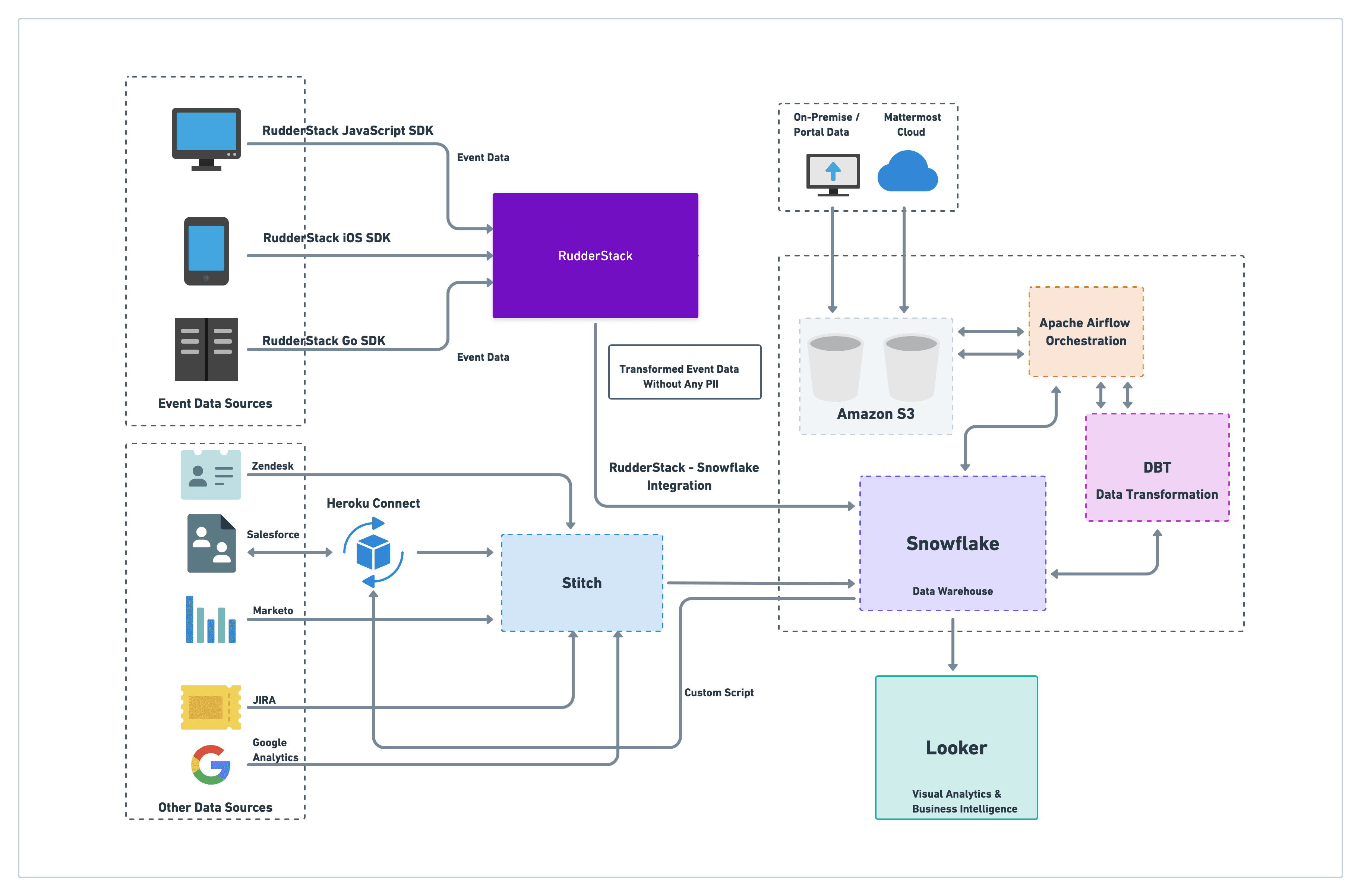Mattermost’s Data Stack Explained: How They Leverage Unlimited Data For Customer Analytics

This post looks at Mattermost’s customer data stack, which allows them to seamlessly leverage unlimited, real-time data across multiple sources to drive various analytics use-cases. We also look at how this data stack aligns with their open-source values and complies with their strict data privacy and security requirements.
Who is Mattermost?
Mattermost is an open-source messaging and collaboration platform that is a popular alternative to enterprise business communication tools like Slack. It is built for high-trust environments, and the deployment is fully self-hosted and brings together all enterprise-wide communications into one place.
As you’d expect from an open-source tool, they offer hundreds of third-party integrations and connect to popular DevOps and developer workflow tools.
How Mattermost use Real-time Customer Data
Mattermost is a highly data-driven company. According to Alex Dovenmuehle, Head of Data Engineering at Mattermost, one of the key use-cases of tracking and collecting real-time event data is to perform effective customer journey mapping.
Real-time events, Alex says, allow teams at Mattermost to understand better how the customers navigate through the product and use it in general. These insights are then used to segment their audiences and build user cohorts. They also run A/B tests on various product-related features and measure their overall impact on the conversion and customer retention rates.
For their internal use-cases, the Mattermost teams make extensive use of data models, visual dashboards, and reports to track various aspects of their performance and overall business health. This includes financial forecasting, tracking their KPIs, and key product usage metrics.
Mattermost’s Data Stack: An Overview
- Cloud – AWS
- Data Collection and Synchronization – RudderStack SDKs, Stitch Data, Heroku Connect, Custom Scripts
- Warehouse: Snowflake
- Data Transformation and Enrichment: RudderStack Transformations, DBT
- BI and Data Querying Toolset: Looker
- Job Orchestration: Apache Airflow
How Data Flows Through Mattermost’s Data Stack
Here’s how the data flows through Mattermost’s customer data stack:
- Mattermost leverages RudderStack’s web, mobile, and server SDKs to collect user events in real-time and route them to their data storage infrastructure. For routing, they utilize RudderStack’s integration for Snowflake, their data warehouse.
- Once all the data is dumped into the warehouse, they use Apache Airflow for job orchestration and scheduling. For data enrichment and transformation, they leverage DBT to convert all raw data across various sources into an aggregated data stream.
- For business analytics and BI use-cases, Mattermost uses Looker to build visual dashboards and reports on top of the DBT data models.
Here’s a visualization of Mattermost’s data stack:

Mattermost’s Customer Data Stack
Data Collection and Storage
A large chunk of data collected by Mattermost comes in user events, which drive most of their analytics and other downstream use-cases. To collect these events in real-time from their web and mobile apps, they use RudderStack’s JavaScript and iOS SDKs, respectively. For the server-side events, they use the Go SDK.
Alex noted that with RudderStack, Mattermost overcame event volume limitations—a problem they faced with their previous vendor. Because of the vendor’s pricing model, they could capture only 2% of their user event data, which meant missing out on valuable customer insights. With RudderStack, Mattermost collects 100% of their event data, giving them rich insights into their customer journeys.
Like their high-trust customers, Mattermost is very data privacy and security-focused. Hence, all the events that are tracked by RudderStack are stripped off any PII (Personally Identifiable Information) before being sent to the data warehouse. They’ve simplified this cleansing process through RudderStack’s Transformation feature, which allows them to strip sensitive information (name, email, etc.) on the event stream in transit.
Learn how RudderStack Transformations can be used to protect the PII in your event data.
Other Data Sources
Apart from customer event data, Mattermost also collects data from various other sources related to marketing messages (Marketo), website metrics (Google Analytics), customer support activity (Zendesk), and various project management components (JIRA) for their internal use-cases. The data coming from their on-premise and cloud solutions go into Amazon S3, and then into the data warehouse.
For storing and processing their Salesforce data, Mattermost uses Heroku Connect – a popular data integration and synchronization service. Mattermost sends all the sales data to their data warehouse through Heroku Connect and syncs the processed and enriched data back to Salesforce through custom scripts. This way, their sales teams always have the most up-to-date insights on customers and users.
Mattermost uses Stitch, a popular ETL solution, to collect the data from all these cloud sources, then dump it into their data warehouse.
Data Warehousing, Orchestration and Enrichment
For handling multiple high-volume data workloads, Mattermost uses Snowflake as their data warehouse. Snowflake allows them to decouple the storage from compute usage in their pricing structure instead of other alternatives like Redshift, which bundles the two together. Alex noted that the flexibility of scaling compute usage according to the needs of various teams is key for managing their stack and infrastructure costs.
For job scheduling and orchestrating, Mattermost uses Apache Airflow’s capabilities for dynamically instantiating pipelines. Alex also appreciates Airflow’s integrations, timely alerting, logging, and monitoring mechanisms.
Finally, Mattermost uses DBT (Data Build Tool) to transform and enrich the data in Snowflake. Alex and the team leverage DBT to define data sources and test the results of their transformations. They also use DBT’s modular SQL queries, which they can update and execute quickly and easily.
Activating the Data for Cutting-Edge Analytics
When it comes to leveraging data models for business intelligence and visualization, Mattermost uses Looker on top of the DBT models. This approach of decoupling data modeling from data visualization allows them to hide any complexities within the data model. It also makes the data easily accessible to the users for quick exploration, dashboarding and reporting.
Also, since the DBT data models contain aggregated data, the Looker views are comprehensive, enriched, and accurate. This allows their team to make the little connections between the data, which usually go unnoticed, which is often where they find the most powerful insights.
Along with the ability to import or export visualizations outside Looker’s dashboard, teams within Mattermost can also use custom webhooks to build third-party visual workflows, eliminating the need to use any other external applications.
In Conclusion
According to Alex, the main drive behind building Mattermost’s data stack was to architect an infrastructure that could bring together all their data in one place, complemented by the tools that allow their users to operate on the data without getting into unnecessary technical complexities.
Today, Alex has helped Mattermost set up a robust customer data stack that allows them to get an end-to-end view of their customer journeys. They can also translate this view into useful insights to build a product that improves the user experience and, in turn, boosts their business.
Sign up for Free and Start Sending Data
Test out our event stream, ELT, and reverse-ETL pipelines. Use our HTTP source to send data in less than 5 minutes, or install one of our 12 SDKs in your website or app. Get started.
Published:
October 12, 2020

Understanding event data: The foundation of your customer journey
Understanding your customers isn't just about knowing who they are—it's about understanding what they do. This is where clean, accurate event data becomes a foundational part of your business strategy.

Data automation: Tools & tactics for automated data processing
With the right automation tools, you can eliminate hours of tedious work while dramatically improving data accuracy and availability. This article explores how data automation works and how it can transform your approach to data management.

How Zoopla transformed real estate experiences with data-driven personalization
Learn how Zoopla, a leader in the UK real estate space, transformed real estate experiences with data-driven personalization and RudderStack's customer data infrastructure.






